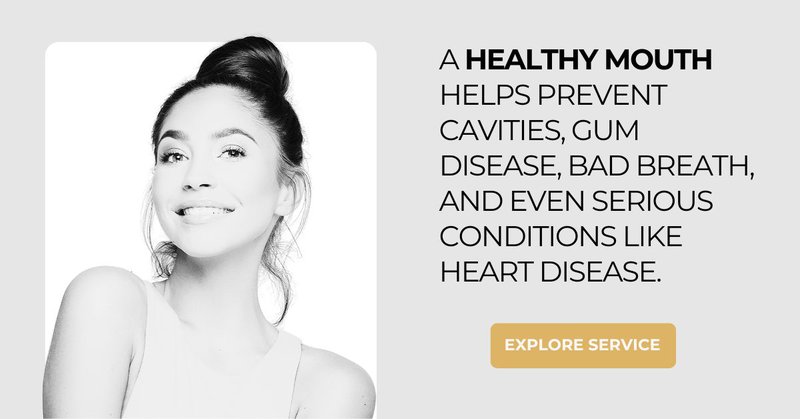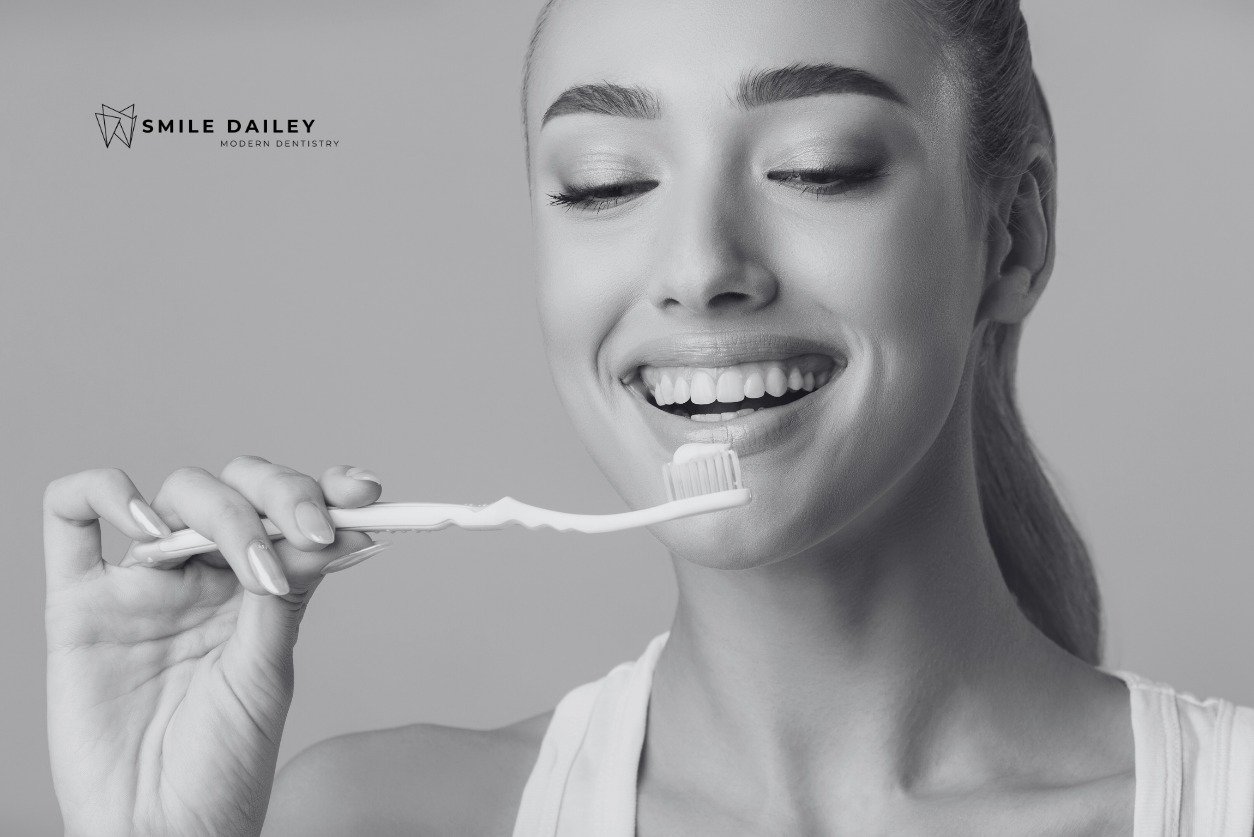Think you’ve got brushing and flossing figured out? Most people miss important steps each day. A weak routine can lead to gum disease, bad breath, or hidden decay. With just a few small changes to your oral care routine, you can protect your smile for life. Here’s how to brush, floss, and clean your mouth—step by step.
Key Takeaways:
- Ideal oral care sequence: Floss → Brush → Scrape tongue → Rinse
- Frequency: Brush twice daily, floss daily, rinse once daily, visit the dentist every 6 months (or 3–4 months if high-risk)
- Tools to use: ADA-approved soft toothbrush, fluoride toothpaste, alcohol-free fluoride mouthwash
- Brush for: 2 minutes total, 30 seconds per quadrant
- Flossing method: 18 inches in “C” shape under the gumline, 10 strokes per side
- Replace toothbrush/tools: Every 3–4 months or when worn
- Best for kids: Start brushing when the first tooth appears; first dental visit by age 1
- Electric brushes: Better at plaque removal than manual brushes
- Diet tips: Fiber-rich foods, water, less sugar/acid; stay hydrated for saliva
- Warning signs: Bleeding gums, bad breath, loose teeth, pain, or mouth sores
- Health links: Poor hygiene raises risks of heart issues, diabetes problems, infections

Build a Better Oral Care Routine for a Healthier Smile
At Smile Dailey Dental, we believe that a healthy mouth is the foundation of a confident, radiant life. While brushing and flossing seem simple, the truth is that the oral care routine you follow—and how consistently you follow it—makes a significant difference. From technique and timing to diet and dental checkups, every step adds up. With the right tools, habits, and guidance, you can protect your smile and boost your overall health for years to come.
Let’s walk through the essential parts of a complete oral care routine—and how to customize it for your needs.
Start with the Right Sequence in Your Oral Care Routine
To get the most out of your daily efforts, it’s important to use the correct order when caring for your teeth and gums. While many people brush first, the most effective oral care routine starts with flossing.
Recommended Sequence:
- Firstly, floss to remove debris between teeth.
- Next, brush with fluoride toothpaste for two full minutes.
- Then, scrape your tongue to eliminate odor-causing bacteria.
- Finally, rinse with alcohol-free fluoride mouthwash.
By flossing first, you clear tight spaces, allowing your toothpaste and brush to reach more surfaces. Subsequently, brushing removes plaque and polishes enamel. Additionally, tongue scraping reduces bad breath, and ultimately, mouthwash provides the final rinse, sweeping away lingering debris.
For more details, check the ADA’s official brushing guide.
Commit to Consistent Daily Timing
Just as important as technique, consistency is key. Brushing and flossing only work when done regularly—and with intention.
Brush twice a day:
- Morning: to remove plaque that forms overnight
- Night: to clean away food and reduce bacterial growth during sleep
Floss once a day, preferably in the evening. This clears food stuck between teeth and helps prevent gum disease.
Use mouthwash once daily—ideally after brushing and flossing at night. Swish for 30 seconds, then avoid eating or drinking for 30 minutes.
Each step has a purpose and works best when done at the right time and for the right duration.
Choose the Best Tools for Optimal Oral Care
The products and tools you choose directly impact your oral care routine success. Therefore, look for the ADA Seal of Acceptance on all dental products—it confirms they are safe and effective.
Toothbrush:
- Firstly, opt for soft-bristled and ADA-approved brushes.
- Additionally, choose a small head for better access.
- Finally, replace it every 3–4 months or sooner if frayed.
Toothpaste:
- It must contain fluoride for effective cleaning.
- Moreover, natural options are fine but still require fluoride.
- Whitening or sensitive formulas can be helpful if approved by your dentist.
Mouthwash:
- To avoid drying, choose alcohol-free varieties.
- Fluoride formulas add enamel strength.
- Furthermore, therapeutic versions can help with gingivitis or dry mouth.
Additional Tools:
- Interdental brushes are particularly useful for braces or wider gaps.
- Floss picks make reaching hard-to-reach areas easier.
- Finally, water flossers are ideal for those with mobility issues.
Need help choosing a brush or floss? Explore Smile Dailey Dental’s services and ask about personalized recommendations during your next visit.
Understand Why Flossing Is Non-Negotiable
Flossing isn't optional—it’s essential because it effectively removes plaque and food particles that brushing alone can't reach.
Proper Flossing Technique:
- First, use 18 inches of floss.
- Then, wrap it around your middle fingers, leaving 1–2 inches to work with.
- Next, curve it into a “C” shape against each tooth.
- Gently slide under the gumline and wipe each side.
- Finally, make sure to use fresh sections as you move along.
If traditional floss is difficult, consider trying floss picks or interdental brushes. These alternatives are easier to grip and are especially beneficial for those with braces or arthritis.
Don’t Forget About Diet and Hydration
Remember, your oral care routine doesn’t end at the sink. What you eat and drink plays a major role in your dental health.
Foods that help:
- Initially, incorporate crunchy fruits and veggies like apples and carrots.
- Additionally, include leafy greens packed with calcium and folate.
- Moreover, consume dairy products like cheese and yogurt.
- Nuts and seeds are excellent for minerals and protein.
- Lastly, drink lots of water to rinse away debris and neutralize acid.
Foods that hurt:
- Be cautious with sugary drinks and snacks (especially sticky ones).
- Limit acidic fruits and juices.
- Avoid dried fruit that clings to teeth.
- Lastly, watch out for soda, energy drinks, and flavored water with hidden sugars.
Hydration matters because saliva is your mouth’s natural cleaner. Staying well hydrated helps keep bacteria in check and supports healthy gums.
For more on how nutrition impacts oral health, visit the CDC’s oral health resources.
Teach and Support Family Oral Care from the Start
Good habits are easier to build than broken ones are to fix. That’s why it’s so important to teach children about oral care early.
For babies and toddlers:
- Wipe gums before teeth come in
- Use a tiny smear of fluoride toothpaste as soon as teeth appear
- Introduce brushing routines with music or games
For kids age 3 and up:
- Supervise and help brush until they can tie their shoes
- Use a pea-sized amount of toothpaste
- Start flossing when teeth begin to touch
- Visit the dentist by age 1, then every 6 months
Use timers, sticker charts, and fun toothbrushes to keep kids engaged. And always lead by example—brush and floss together as a family!
Watch for Signs That Your Routine Needs a Boost
Even with daily brushing, there are, nonetheless, some signs indicating that your oral care routine may need improvement:
- Bleeding or swollen gums
- Constant bad breath
- Tooth sensitivity
- Buildup along the gumline
- Mouth sores that don’t heal
These are signs of trouble, often arising from missed plaque or poor technique. Therefore, if you notice them, it's crucial to schedule a dental visit and review your habits.
To fix bad breath naturally:
- Start by scraping your tongue
- Additionally, stay hydrated
- Also, limit sugar intake
- Finally, rinse with mouthwash at night
For more on early warning signs, check out the NIH’s oral care guide.
Adjust Your Oral Routine for Special Conditions
Braces, implants, dry mouth, or gum recession require extra care. But with a few tweaks, your routine can still be effective.
Braces:
- Brush after every meal
- Use floss threaders or water flossers
- Add the Charters brushing method for cleaning around brackets
Dental Implants:
- Use soft brushes and non-abrasive toothpaste
- Clean around the base with floss or interdental brushes
- Rinse daily with an antimicrobial mouthwash
Sensitive Teeth:
- Use desensitizing toothpaste
- Avoid hard bristles and hot or cold rinses
- Brush gently—no scrubbing
Dry Mouth:
- Sip water frequently
- Use mouth rinses made for dry mouth
- Ask about xylitol gum or lozenges
Receding Gums:
- Use the Stillman or Modified Stillman brushing method
- Avoid aggressive brushing
- Choose toothpaste for gum health
Never Skip Regular Dental Visits
Even with the best at-home care, professional cleanings and checkups are essential.
Why schedule visits every 6 months?
- Remove hardened tartar
- Spot early signs of decay or gum disease
- Monitor oral cancer and overall health
- Receive fluoride treatments or sealants if needed
High-risk patients (those with diabetes, gum disease, or many fillings) may need visits every 3–4 months.
Signs it’s time to go now:
- Bleeding gums
- Toothaches
- Jaw pain
- Loose or shifting teeth
- Persistent bad breath
Your dentist is your partner in oral health. Don’t wait until it hurts.
Understand the Link Between Oral Health and Total Body Health
Your mouth isn’t separate from the rest of your body. In fact, poor oral hygiene can contribute to serious health issues.
Linked Conditions:
- Heart disease: Gum inflammation may raise heart risk
- Diabetes: Gum infections make blood sugar harder to manage
- Respiratory issues: Mouth bacteria can affect the lungs
- Pregnancy complications: Gum disease may increase risks
- Cognitive decline: Gum problems are linked to dementia
By brushing, flossing, and keeping gums healthy, you protect more than your teeth—you protect your entire system.
For more on this, see the Office on Women’s Health oral care page.
Ready to Upgrade Your Oral Care Routine?
Let’s Keep Your Smile Strong, Together
At Smile Dailey Dental, we’re here to help you build a better oral care routine that fits your unique smile. Whether you need help with technique, tools, or timing, our team is ready to guide you. Let’s work together to protect your teeth, improve your confidence, and support your total health—one day at a time.
Contact us today to schedule your visit.
We’re proud to be Little Rock’s trusted resource for healthy, lasting smiles.

